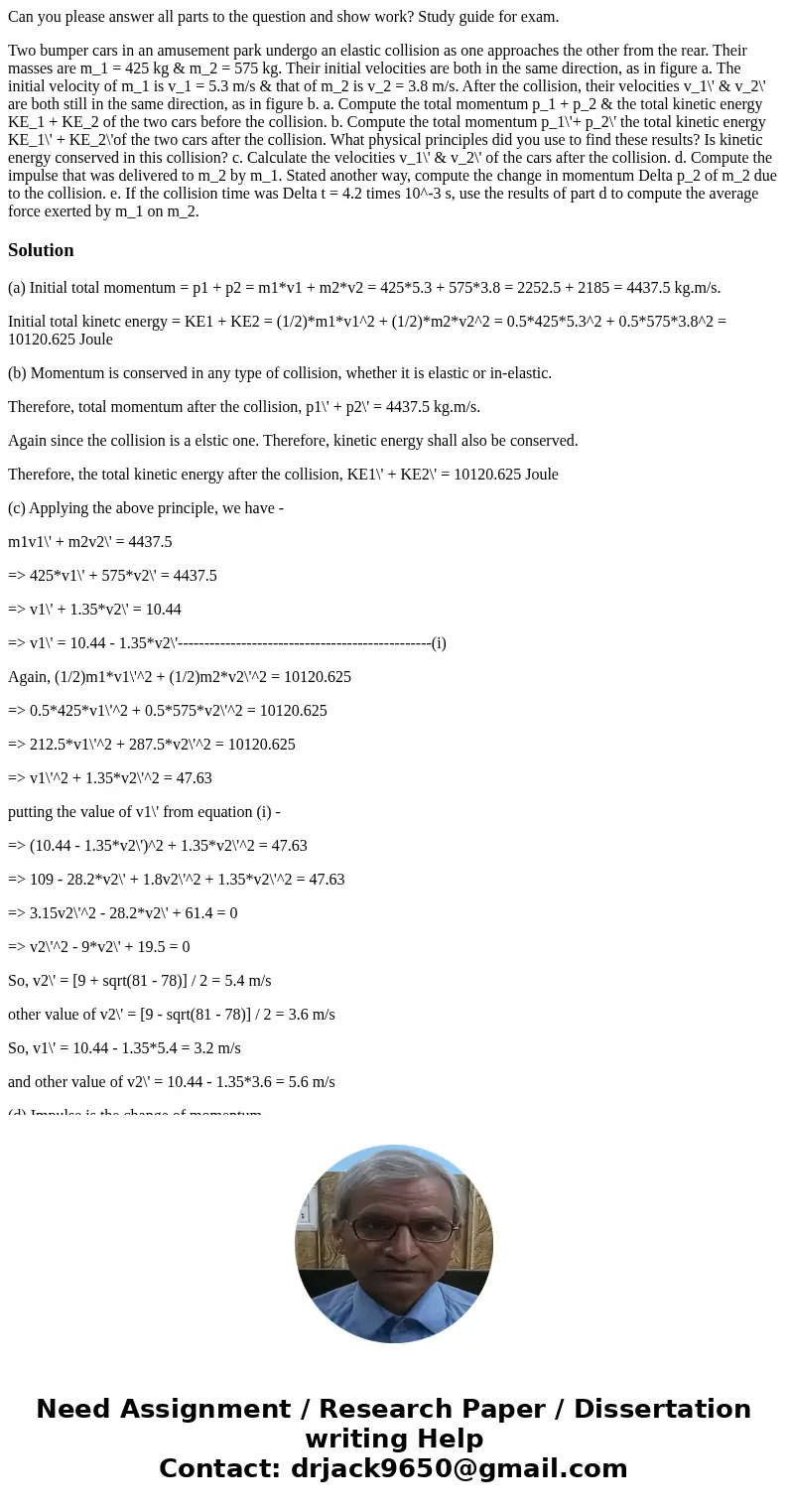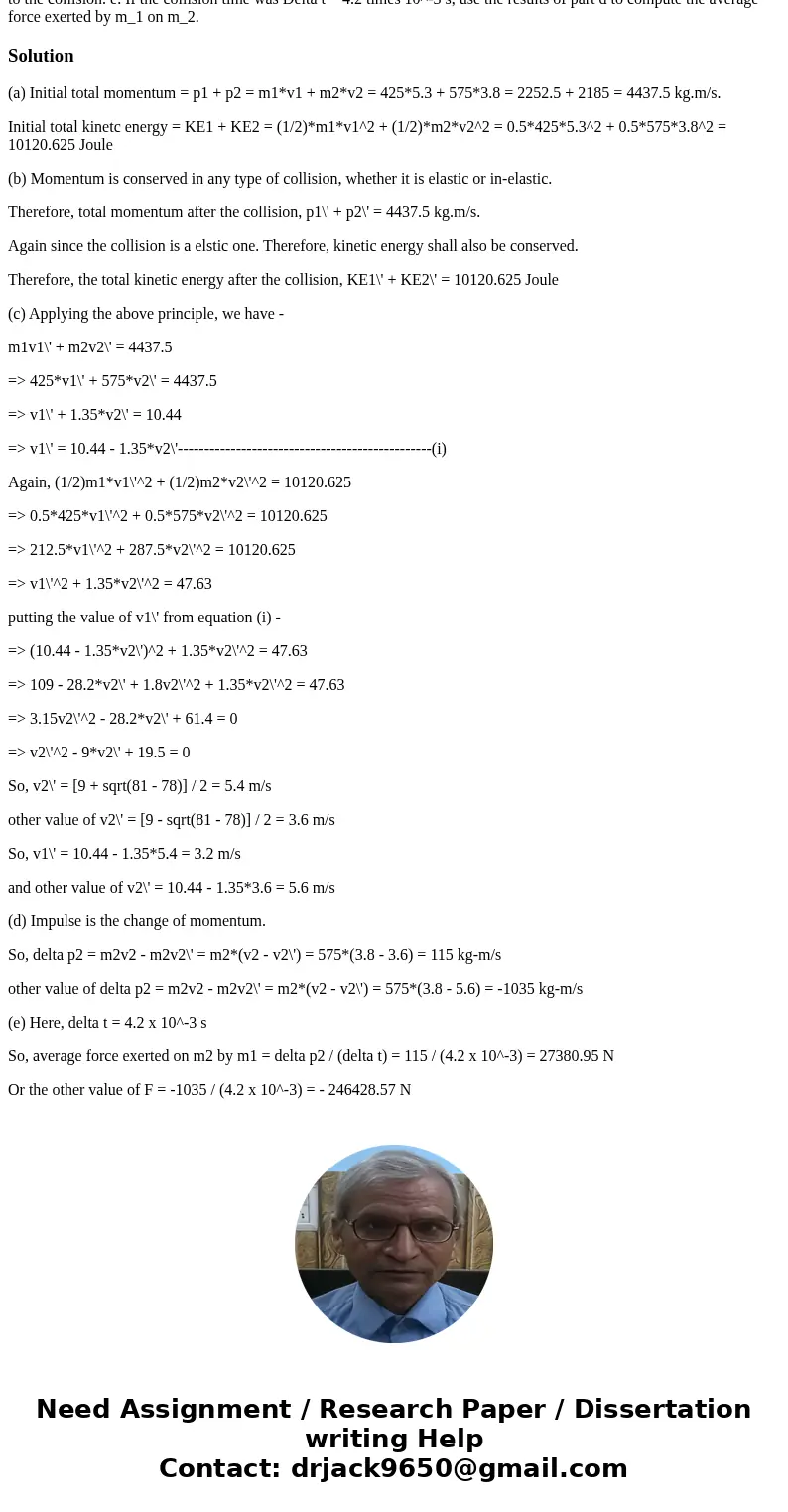Can you please answer all parts to the question and show wor
Can you please answer all parts to the question and show work? Study guide for exam.
Two bumper cars in an amusement park undergo an elastic collision as one approaches the other from the rear. Their masses are m_1 = 425 kg & m_2 = 575 kg. Their initial velocities are both in the same direction, as in figure a. The initial velocity of m_1 is v_1 = 5.3 m/s & that of m_2 is v_2 = 3.8 m/s. After the collision, their velocities v_1\' & v_2\' are both still in the same direction, as in figure b. a. Compute the total momentum p_1 + p_2 & the total kinetic energy KE_1 + KE_2 of the two cars before the collision. b. Compute the total momentum p_1\'+ p_2\' the total kinetic energy KE_1\' + KE_2\'of the two cars after the collision. What physical principles did you use to find these results? Is kinetic energy conserved in this collision? c. Calculate the velocities v_1\' & v_2\' of the cars after the collision. d. Compute the impulse that was delivered to m_2 by m_1. Stated another way, compute the change in momentum Delta p_2 of m_2 due to the collision. e. If the collision time was Delta t = 4.2 times 10^-3 s, use the results of part d to compute the average force exerted by m_1 on m_2.Solution
(a) Initial total momentum = p1 + p2 = m1*v1 + m2*v2 = 425*5.3 + 575*3.8 = 2252.5 + 2185 = 4437.5 kg.m/s.
Initial total kinetc energy = KE1 + KE2 = (1/2)*m1*v1^2 + (1/2)*m2*v2^2 = 0.5*425*5.3^2 + 0.5*575*3.8^2 = 10120.625 Joule
(b) Momentum is conserved in any type of collision, whether it is elastic or in-elastic.
Therefore, total momentum after the collision, p1\' + p2\' = 4437.5 kg.m/s.
Again since the collision is a elstic one. Therefore, kinetic energy shall also be conserved.
Therefore, the total kinetic energy after the collision, KE1\' + KE2\' = 10120.625 Joule
(c) Applying the above principle, we have -
m1v1\' + m2v2\' = 4437.5
=> 425*v1\' + 575*v2\' = 4437.5
=> v1\' + 1.35*v2\' = 10.44
=> v1\' = 10.44 - 1.35*v2\'------------------------------------------------(i)
Again, (1/2)m1*v1\'^2 + (1/2)m2*v2\'^2 = 10120.625
=> 0.5*425*v1\'^2 + 0.5*575*v2\'^2 = 10120.625
=> 212.5*v1\'^2 + 287.5*v2\'^2 = 10120.625
=> v1\'^2 + 1.35*v2\'^2 = 47.63
putting the value of v1\' from equation (i) -
=> (10.44 - 1.35*v2\')^2 + 1.35*v2\'^2 = 47.63
=> 109 - 28.2*v2\' + 1.8v2\'^2 + 1.35*v2\'^2 = 47.63
=> 3.15v2\'^2 - 28.2*v2\' + 61.4 = 0
=> v2\'^2 - 9*v2\' + 19.5 = 0
So, v2\' = [9 + sqrt(81 - 78)] / 2 = 5.4 m/s
other value of v2\' = [9 - sqrt(81 - 78)] / 2 = 3.6 m/s
So, v1\' = 10.44 - 1.35*5.4 = 3.2 m/s
and other value of v2\' = 10.44 - 1.35*3.6 = 5.6 m/s
(d) Impulse is the change of momentum.
So, delta p2 = m2v2 - m2v2\' = m2*(v2 - v2\') = 575*(3.8 - 3.6) = 115 kg-m/s
other value of delta p2 = m2v2 - m2v2\' = m2*(v2 - v2\') = 575*(3.8 - 5.6) = -1035 kg-m/s
(e) Here, delta t = 4.2 x 10^-3 s
So, average force exerted on m2 by m1 = delta p2 / (delta t) = 115 / (4.2 x 10^-3) = 27380.95 N
Or the other value of F = -1035 / (4.2 x 10^-3) = - 246428.57 N


 Homework Sourse
Homework Sourse